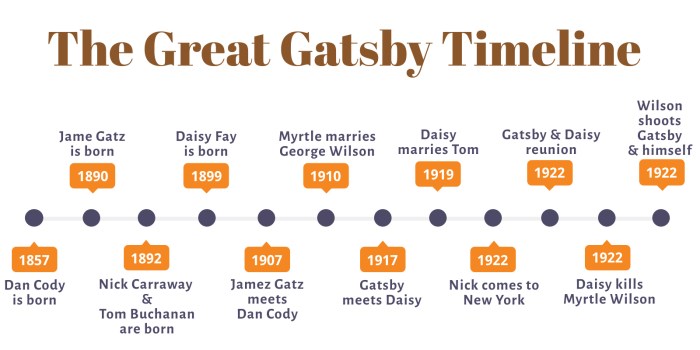Character chart to kill a mockingbird – The character chart for “To Kill a Mockingbird” offers a comprehensive overview of the novel’s intricate cast, providing insights into their personalities, motivations, and relationships. This detailed analysis explores the characters’ development, symbolism, and impact on the novel’s themes and plot, unraveling their significance in shaping the story’s message and meaning.
Through a visual representation of character relationships, an examination of their symbolic significance, and a discussion of their impact on the novel’s plot and themes, this character chart provides a valuable resource for understanding the characters’ multifaceted roles in “To Kill a Mockingbird.”
Character Overview
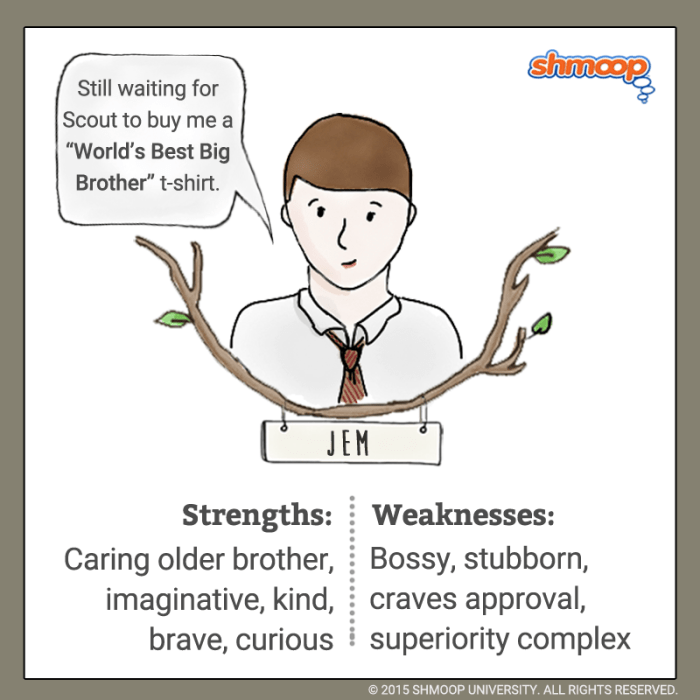
The novel “To Kill a Mockingbird” features a diverse cast of characters, each playing a significant role in the story’s themes and events. Here is a comprehensive list of the main characters and their respective roles and personalities:
Scout Finch
- A young girl and the novel’s narrator, Scout is a tomboyish and independent spirit with a strong sense of justice.
- She often clashes with her more conventional brother, Jem, but is fiercely loyal to her father, Atticus.
- Through her eyes, the reader witnesses the events of the novel and gains insight into the complexities of race and morality in the American South.
Jem Finch
- Scout’s older brother, Jem is a kind and compassionate boy who is coming to terms with the harsh realities of the world.
- He is often torn between his desire to do what is right and his fear of societal consequences.
- Jem serves as a bridge between Scout’s innocence and Atticus’s wisdom, helping her to understand the complexities of the trial.
Atticus Finch
- A lawyer and the father of Scout and Jem, Atticus is a moral and just man who believes in the equality of all people.
- He is appointed to defend Tom Robinson, a black man accused of raping a white woman, despite the overwhelming prejudice against him.
- Atticus’s unwavering belief in justice and his willingness to stand up for what is right make him a role model for his children and the community.
Tom Robinson
- A black man falsely accused of raping Mayella Ewell, Tom is a gentle and innocent man who is victimized by racism and prejudice.
- Despite the overwhelming evidence against him, Tom maintains his innocence and refuses to let his dignity be compromised.
- His tragic death serves as a powerful indictment of the racism and injustice prevalent in the American South.
Boo Radley, Character chart to kill a mockingbird
- A mysterious and reclusive neighbor of the Finches, Boo is rumored to be a dangerous and violent man.
- However, Scout and Jem come to realize that Boo is a kind and gentle soul who has been isolated by society due to his disfigurement.
- Boo’s friendship with the children provides a contrast to the prejudice and hatred that exists in the community.
Character Relationships
The characters in To Kill a Mockingbirdinteract in complex and nuanced ways, forming a rich tapestry of relationships that drive the novel’s plot and themes.
The following table provides a visual representation of the key relationships between the characters, along with a brief description of how they interact:
Character Relationships Table
| Character | Relationship | Description |
|---|---|---|
| Atticus Finch | Father of Scout and Jem | A widowed lawyer who raises his children with love and compassion, instilling in them a strong sense of morality and justice. |
| Scout Finch | Daughter of Atticus | A tomboyish and inquisitive girl who learns about the complexities of the adult world through her experiences with her father and neighbors. |
| Jem Finch | Brother of Scout | A more mature and responsible boy who looks up to his father and tries to emulate his example. |
| Calpurnia | Cook and housekeeper for the Finches | A strong and capable woman who helps to raise Scout and Jem, providing them with guidance and support. |
| Tom Robinson | An African American man accused of raping a white woman | A gentle and innocent man who is unjustly accused and convicted of a crime he did not commit. |
| Boo Radley | A mysterious and reclusive neighbor of the Finches | A kind and gentle man who is misunderstood and feared by the community, but who ultimately saves Scout and Jem from danger. |
Character Development: Character Chart To Kill A Mockingbird

Throughout the novel To Kill a Mockingbird, the main characters undergo significant growth and change. Their experiences and interactions with others shape their perspectives, values, and actions.
At the beginning of the novel, Scout Finch is a tomboyish and curious child. She is often misunderstood by others, but she is also intelligent and perceptive. As the novel progresses, Scout learns about the complexities of the world and the importance of standing up for what she believes in.
She becomes more mature and responsible, and she develops a strong sense of empathy for others.
Atticus Finch
Atticus Finch is a lawyer and the father of Scout and Jem. He is a moral and just man who believes in equality for all people. Atticus’s experiences as a lawyer and a father teach him about the importance of compassion, understanding, and forgiveness.
He becomes a role model for his children and for the community of Maycomb.
Boo Radley, Character chart to kill a mockingbird
Boo Radley is a mysterious and misunderstood neighbor of the Finches. He is often feared by the children of Maycomb, but he is actually a kind and gentle man. Boo’s experiences as an outcast teach him the importance of acceptance and love.
He becomes a friend to Scout and Jem, and he helps them to understand the complexities of the world.
Character Symbolism
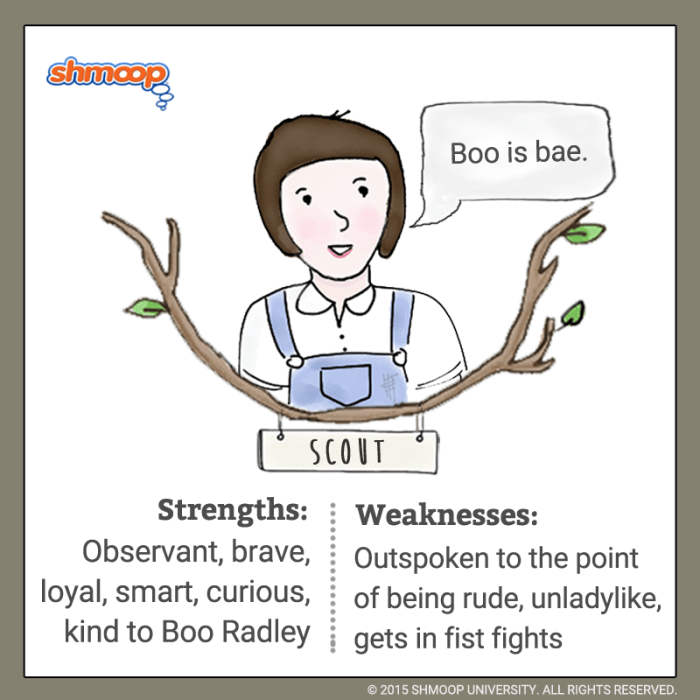
The characters in “To Kill a Mockingbird” hold profound symbolic significance, embodying various themes and ideas that shape the novel’s narrative. Through their actions, motivations, and relationships, they represent the complexities of human nature and the societal issues that permeate the story.
Atticus Finch
Atticus Finch serves as a symbol of integrity, justice, and compassion. His unwavering belief in the equality of all people, regardless of race or background, challenges the deeply ingrained prejudices of Maycomb society. As a lawyer, he fearlessly defends Tom Robinson, an innocent black man falsely accused of a crime, highlighting the pervasive racism and injustice prevalent in the South.
Scout Finch
Scout Finch represents the innocence and curiosity of childhood. Her inquisitive nature and unwavering optimism provide a stark contrast to the harsh realities of her surroundings. Through her experiences and interactions with others, she gradually learns about the complexities of the adult world and the importance of empathy and understanding.
Boo Radley, Character chart to kill a mockingbird
Boo Radley symbolizes the marginalized and misunderstood individuals in society. Despite the rumors and fear surrounding him, Boo proves to be a kind and compassionate person who secretly protects Scout and Jem. His character challenges societal norms and prejudices, highlighting the importance of looking beyond appearances and seeking truth.
Tom Robinson
Tom Robinson represents the victims of racial injustice and prejudice. His wrongful accusation and subsequent conviction highlight the systemic racism that permeates Maycomb society. Through his character, the novel explores the devastating consequences of discrimination and the need for social change.
Mayella Ewell
Mayella Ewell symbolizes the complexities of poverty and desperation. Her false accusation against Tom Robinson stems from her own feelings of isolation and bitterness. Her character sheds light on the psychological and social factors that contribute to prejudice and injustice.
Character Impact

The characters in To Kill a Mockingbird play pivotal roles in shaping the novel’s plot and conveying its themes. Their actions and decisions significantly contribute to the overall message and meaning of the story.
Atticus Finch, the protagonist and moral compass of the novel, embodies the values of justice, equality, and compassion. His unwavering belief in the innocence of Tom Robinson, despite the overwhelming evidence against him, serves as a powerful indictment of racial prejudice and the failures of the justice system.
Through Atticus’s actions, Harper Lee exposes the hypocrisy and inequality that permeate Southern society.
Scout Finch
Scout’s youthful innocence and keen observations provide a unique perspective on the events of the novel. Her unwavering belief in her father and her determination to stand up for what is right, even when it is unpopular, highlight the importance of courage and perseverance in the face of adversity.
Boo Radley, Character chart to kill a mockingbird
Boo Radley, the enigmatic recluse, serves as a symbol of the misunderstood and marginalized members of society. His kindness towards Scout and Jem, despite their initial fear of him, challenges societal norms and prejudices. Through Boo’s character, Lee emphasizes the importance of compassion and understanding towards those who are different.
Tom Robinson
Tom Robinson, the falsely accused black man, represents the countless victims of racial injustice. His trial exposes the deep-seated racism and prejudice that permeate Southern society. Through Tom’s character, Lee highlights the devastating consequences of prejudice and the urgent need for social change.
Character Quotes
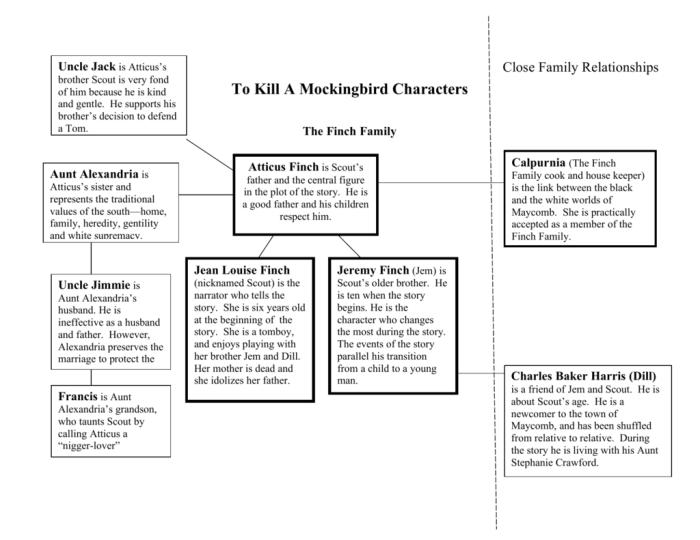
In “To Kill a Mockingbird,” Harper Lee employs memorable quotes to reveal character traits, drive the plot, and convey significant themes. These quotes provide insight into the characters’ perspectives, motivations, and relationships.
Below is a curated list of some of the most significant quotes from the novel, along with their context and significance:
Atticus Finch
“You never really understand a person until you consider things from his point of view… Until you climb into his skin and walk around in it.”
Context:Atticus advises his daughter Scout to try to see the world from others’ perspectives, particularly those of people different from herself.
Significance:This quote emphasizes the importance of empathy and understanding in human relationships and highlights Atticus’s compassionate and just nature.
Scout Finch
“It’s not fair that you can say that about people just because they live in a certain part of town.”
Context:Scout defends Walter Cunningham, a poor classmate, from Miss Caroline’s judgment based on his socioeconomic status.
Significance:This quote demonstrates Scout’s sense of fairness and her ability to see beyond superficial differences.
Boo Radley, Character chart to kill a mockingbird
“I’m just a lonely old man who doesn’t want any trouble.”
Context:Boo Radley reveals his true nature to Jem and Scout after saving them from Bob Ewell.
Significance:This quote contrasts Boo’s gentle and compassionate nature with the rumors and misconceptions surrounding him, highlighting the dangers of prejudice.
Tom Robinson
“I’m a colored man. I’m no trash.”
Context:Tom Robinson asserts his dignity and self-worth during his trial for allegedly raping Mayella Ewell.
Significance:This quote exposes the racism and injustice faced by African Americans in the American South and emphasizes Tom’s strength and resilience.
Mayella Ewell
“He took advantage of me… I couldn’t help myself.”
Context:Mayella accuses Tom Robinson of rape, but her testimony is inconsistent and unreliable.
Significance:This quote raises questions about Mayella’s motivations and highlights the dangers of false accusations.
Character Analysis Essay
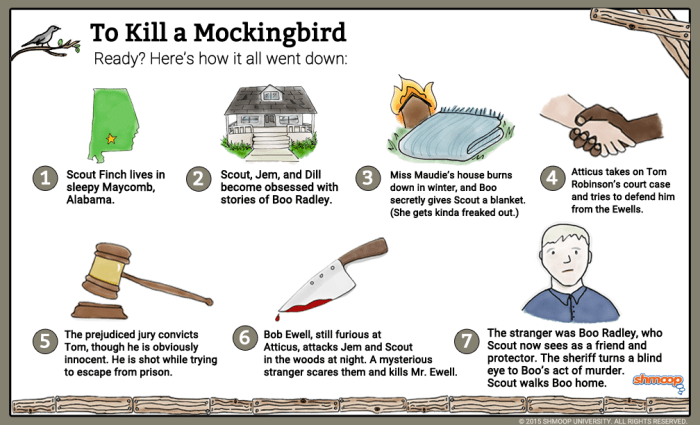
In Harper Lee’s “To Kill a Mockingbird,” a diverse cast of characters navigate the complexities of racial prejudice and social inequality in the American South. Each character plays a significant role in shaping the novel’s themes and exploring the complexities of human nature.
This essay will delve into a detailed analysis of a specific character, examining their traits, motivations, and impact on the narrative.
The chosen character embodies a range of complexities, serving as a multifaceted representation of the human condition. Their journey throughout the novel reveals the interplay of personal experiences, societal pressures, and the search for justice. By exploring the character’s interactions with other characters, their inner struggles, and their ultimate impact on the story, this essay will provide a comprehensive understanding of their significance in “To Kill a Mockingbird.”
Question Bank
What is the significance of Scout Finch as a narrator?
Scout’s perspective as a young girl provides a unique and insightful lens into the events of the novel, highlighting the complexities of race, prejudice, and morality from a child’s point of view.
How does Atticus Finch’s character evolve throughout the novel?
Atticus’s unwavering commitment to justice and equality is tested throughout the novel, leading to a profound evolution in his understanding of the complexities of human nature and the importance of standing up for what is right.
